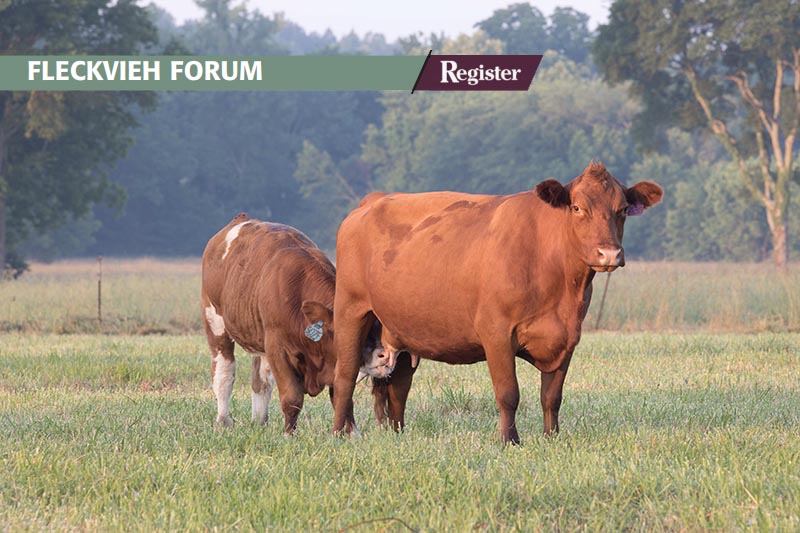by Larry H. Maxey, founder and superintendent, NAILE Fullblood Simmental Shows
Our Pioneers — Tom Risinger

Sadly I learned of the passing of Tom Risinger while reading the March 2025 Register . Unquestionably, Tom was a legend in the Simmental breed. His contributions to our fledgling breed association during our formative years assisted the ASA during very difficult times. I shudder to think of the possible outcomes without his wisdom and thoughtful insights.
Sometime in early 2021, Dr. Wade Shafer and I had a conversation about those early pioneers who formed the ASA. Tom Risinger’s name readily rose to the top of the list. Dr. Shafer shared some of his memories and knowledge about Tom’s importance to the ASA. Later, Dr. Bob Hough, author of Simmental’s American Journey , highly recommended that I contact Tom and helped me with those arrangements. My hope was that Tom would be agreeable to being profiled in the “Our Pioneers” series for the Fleckvieh Forum column. My phone contact with Tom and his wife, Diane, was enlightening and very worthwhile. The following article was printed in this column in the July/August 2021 edition of the Register, and that conversation and more is being reprinted here as a tribute to the life and times of Tom Risinger and his lasting influence to the ASA and our Simmental breed.
When Amor 1A arrived in the US, events had actually moved at warp speed given the fact that Parisien, Amor’s sire, had only been in Canada for about three years. Understandably, there were great expectations for Parisien, who had arrived in Canada from Europe in 1967. Some very wise producers saw the potential to fundamentally change the beef cattle industry in North America. They were right in that belief, as Parisien was a great sire, and Travers Smith and his partners were fortunate to have selected such a fine specimen. The breed’s foundation was firm. Amor 1A had been sold by Travers and his SBL partners for the incredible sum of $154,000 to a US syndicate. One member was from Oklahoma and the remaining six were from Texas. One of those Texans was our featured pioneer for the July/August 2021 edition: Tom Risinger.
In Simmental’s American Journey , Hough explains Tom Risinger’s involvement with the fledgling ASA. At that time, the organization was under the leadership of an interim, unpaid executive secretary, Dale Lynch. The ASA was on shaky financial grounds. With the increasing demand for services, the ASA Board considered Risinger as a capable person “to be brought in to train and help (Lynch) relieve some of the workload.” Tom was really not interested in the position but allowed his name to be considered. “When the trustees agreed to hire a full-time executive, Risinger was more than happy to withdraw from consideration.” Don Vaniman, another pioneer, was subsequently hired as the first full-time executive secretary.
In my efforts to learn more about that syndicate, I contacted Tom and Diane Risinger by phone. I found them to be the most pleasant and cordial people one could ever hope to encounter. It became clear that Tom and Diane cherished their memories of their many years in the cattle business. Most cherished, of course, were their recollections of the many wonderful and fine people they encountered along a very long and successful career. Diane explained her role as the keeper of the books and recalled the challenges in trying to keep track of the records of 1,200 head of cattle. And even though they had been retired for several years, they were aware of the rapid advance and interest in performance and genetic information at the forefront of the industry.
When we got around to the topic of the syndicate that purchased Amor 1A, Diane chuckled at the term “syndicate,” so we decided to describe it as the “Group of Seven.” Tom recalled the excitement they had in being part of that historic event. As to my inquiry about the makeup of the other six members, Tom advised me that I was “almost too late” as just about everyone involved is no longer with us. He gave credit to Bert Reyes for being the driving force behind the negotiations to purchase Amor. (As a side note, for those interested in the life and legacy of a truly great cattle person, I recommend you check out the history and contributions of this remarkable man, Bert Reyes, which can be found online.)
In conclusion, I am so pleased to have spoken to the Risingers. Over 50 years ago, their interest in performance improvement for their cattle led them to the Simmental breed. They saw the potential to dramatically improve the beef cattle herds in North America by using Simmental genetics, more so in crossbreeding and the many advantages of heterosis. Major investments in genetics, such as their role in the Amor 1A purchase, were risky, of course, but only trial and error over time would determine the benefits. I think it can be safely concluded that the Risingers were highly successful over a long and illustrious career. Thankfully, our Simmental breed has been a direct beneficiary of the contributions made by one of our true pioneers, Tom Risinger, and following my conversation with them we can include Diane as well. Many thanks and we are grateful! .
Editor’s note: This is the forty-fifth in the series Our Pioneers.
Is there a Simmental pioneer who you would like to see profiled in this series? Reach out to Larry Maxey or the editor to submit your suggestions:


